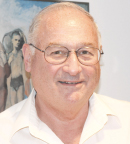A weekly schedule of nab-paclitaxel as part of neoadjuvant chemotherapy significantly improved pathologic complete response compared with nab-paclitaxel given 2 weeks out of every 3 weeks (2/3) in patients with primary breast cancer, with a greater magnitude of benefit in patients with triple-negative breast cancer. However, the addition of the RANK ligand inhibitor denosumab to neoadjuvant chemotherapy had no impact on pathologic complete response. These preliminary findings of the pathologic complete response rates in the GeparX study were presented at the 2019 San Antonio Breast Cancer Symposium.1

Jens-Uwe Blohmer, MD
“Anticancer activity of RANK ligand inhibition with denosumab is still under discussion [in patients with breast cancer],” according to lead study author Jens-Uwe Blohmer, MD, of Charité Hospital, Berlin. “Previous studies suggested that denosumab can prevent or delay bone metastasis and improve disease-free survival in postmenopausal women with breast cancer. Also, it remains unclear which administration regimen should be preferred for nab-paclitaxel. GeparX investigated whether the addition of denosumab to anthracycline/taxane-containing neoadjuvant chemotherapy increases the pathologic complete response rate and which nab-paclitaxel schedule should be preferred for primary breast cancer.”
Dr. Blohmer continued: “In our study, denosumab did not increase pathologic complete response rates in patients with early breast cancer. Nab-paclitaxel on a weekly schedule resulted in significantly higher pathologic complete response rates compared with the 2/3 schedule. However, higher rates of serious adverse events and higher rates of treatment discontinuations—mainly due to adverse events—were observed with weekly nab-paclitaxel. In the cohort with triple-negative breast cancer, remarkable pathologic complete response rates were observed with weekly nab-paclitaxel followed by carboplatin. Research [on the best paclitaxel schedule] is still ongoing,” he said.
Study Details
GeparX was a multicenter, prospective, open-label, randomized phase IIb trial with a 2×2 factorial design to compare the addition of denosumab to neoadjuvant chemotherapy and to evaluate two different schedules of nab-paclitaxel as part of neoadjuvant chemotherapy in patients with breast cancer. The study randomly assigned 778 patients to receive neoadjuvant chemotherapy plus or minus denosumab at 120 mg subcutaneously every 4 weeks for 6 cycles plus epirubicin/cyclophosphamide every 2 weeks vs every 3 weeks. Next, patients were randomly assigned to different taxane backbones: nab-paclitaxel at 125 mg/m2 weekly plus epirubicin/cyclophosphamide or nab-paclitaxel at 125 mg/m2 on days 1 and 8 every 22 days (2/3) with the same chemotherapy. No prior denosumab was allowed. Patients with HER2-positive breast cancer received trastuzumab and pertuzumab. Those with triple-negative breast cancer received carboplatin 12 times every week.
There were more discontinuations of treatment due to adverse events in the weekly nab-paclitaxel arm: 20.6% vs 6.3% in the 2/3 arm. About 30% of patients experienced at least one serious adverse event, and slightly more hematologic and gastrointestinal serious adverse events were reported in the weekly paclitaxel arms.
KEY POINTS
- The addition of denosumab to anthracycline/taxane-based chemotherapy failed to improve pathologic complete response in primary breast cancer.
- A weekly schedule of nab-paclitaxel increased pathologic complete response rates compared with a 2-week-out-of-3-week schedule, but at the cost of higher toxicity.
- The optimal schedule for nab-paclitaxel is still under discussion. Further follow-up is needed.
A total of 343 serious adverse events were reported in 214 patients evaluable for safety. The rate of patients with at least one serious adverse event was higher with weekly nab-paclitaxel than in the 2/3-week arm: 30.8% vs 24.1%, irrespective of the addition of denosumab.
Pathologic Complete Response
Pathologic complete response rates were not significantly affected by the addition of denosumab: 41% for patients who received denosumab and 43% for those who did not.
However, a trend was observed for significance regarding pathologic complete response rates with weekly nab-paclitaxel: 44.9% vs 39% for the 2/3 schedule. Among patients with triple-negative breast cancer, the pathologic complete response rate was 60.4% with weekly nab-paclitaxel vs 50% with the other schedule, for an absolute difference of 10.4%. Among patients with HER2-positive disease, the rates of pathologic complete response were not significantly different for the two nab-paclitaxel schedules: 57.9% vs 51.9%, respectively. Rates were quite similar for patients with hormone receptor–positive/HER2-negative disease: 22.6% vs 213%, respectively.
“Remarkably, patients with triple-negative breast cancer had higher pathologic complete response rates with weekly nab-paclitaxel vs every 3 weeks out of 4 nab-paclitaxel,” Dr. Blohmer pointed out. “No significant difference was observed with the two different schedules of nab-paclitaxel in other groups, such as those with hormone receptor–positive and HER2-positive disease,” he added.
Issue of Peripheral Neuropathy
Following the presentation, audience member Steven E. Vogl, MD, a practicing oncologist in the Bronx, New York, expressed concern about diminished quality of life that may result from the weekly paclitaxel regimen, particularly due to peripheral neuropathy. “How many patients had prolonged and significant neuropathy after they were finished,” asked Dr. Vogl. “In the previous GeparSepto trial, where 125 mg/m2 of nab-paclitaxel was actually reduced from 150 mg/m2, some of us thought that was too much neuropathy for our patients, because the ones who survived were moderately miserable. It’s no good to be in complete pathologic response and miserable. How many people had prolonged neuropathy?”

Steven E. Vogl, MD
Dr. Blohmer responded: “[Neuropathy] was one of our secondary study endpoints, but we haven’t yet reported the results.... We will present these data later, at least during our full publication.”
Additional Commentary
Commenting on the negative findings regarding denosumab, Adam Brufsky, MD, Co-Director of the Breast Cancer at UPMC Hillmen Cancer Center, Pittsburgh, said: “I’m not surprised by these findings. The DCARE study failed to show a survival benefit with denosumab. Denosumab works to decrease the risk of fracture.”
Dr. Brufsky noted that 5 years ago, zoledronic acid was shown to have a 3% benefit in breast cancer–specific survival in postmenopausal women with breast cancer. “We thought denosumab could do that, but the trials failed to show an effect on survival. Zoledronic acid prevents bone metastasis and death in women with breast cancer. We should be using it,” concluded Dr. Brufsky.
DISCLOSURE: The study was funded by Amgen and Celgene. Dr. Blohmer received honoraria from Amgen, AstraZeneca, Pharma Mar, Daiichi Sankyo, Genomic Health, MSD Oncology, Myriad Genetics, Novartis/Pfizer, Roche, and Sonoscape; and has been reimbursed for travel, accommodations, or expenses by Pfizer and Roche. Dr. Vogl’s spouse owns stock or other ownership interests in Amgen and Bristol-Myers Squibb. Dr. Brufsky has served as a consultant or advisor to Agendia, Bayer, Bioarray Therapeutics, bioTheranostics, Celgene, Eisai, Genentech/Roche, Genomic Health, Lilly, Merck, Myriad Pharmaceuticals, NanoString Technologies, Novartis, Pfizer, Puma Biotechnology, Amgen, and AstraZeneca.
REFERENCE
1. Blohmer JU, et al: Investigating denosumab as an add-on treatment to neoadjuvant chemotherapy and two different nab-paclitaxel schedules in a 2x2 design in primary breast cancer. 2019 San Antonio Breast Cancer Symposium. Abstract GS3-01. Presented December 12, 2019.

